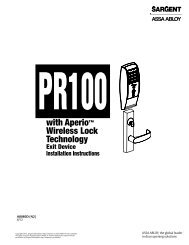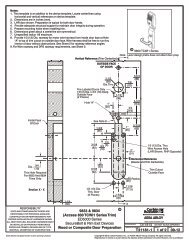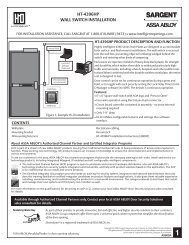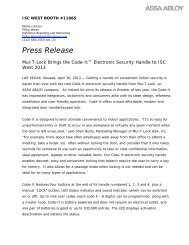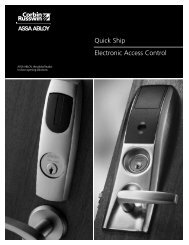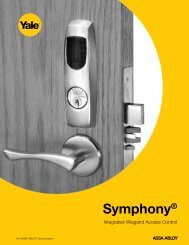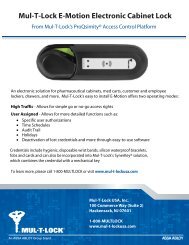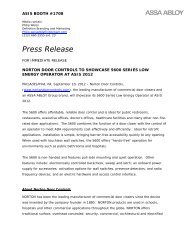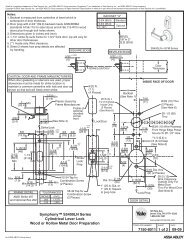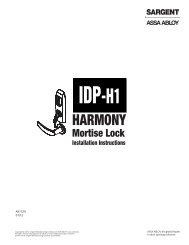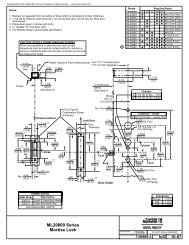CORBIN RUSSWIN Access 800 IP1 PoE Catalog - Access Control ...
CORBIN RUSSWIN Access 800 IP1 PoE Catalog - Access Control ...
CORBIN RUSSWIN Access 800 IP1 PoE Catalog - Access Control ...
You also want an ePaper? Increase the reach of your titles
YUMPU automatically turns print PDFs into web optimized ePapers that Google loves.
Architectural Specifications<br />
<strong>IP1</strong><br />
ML20<strong>800</strong> x TC<strong>IP1</strong> Series<br />
Mortise Locks<br />
Intelligent Power over Ethernet (<strong>PoE</strong>)<br />
<strong>Access</strong> <strong>Control</strong><br />
1. <strong>PoE</strong> access control mortise locks shall be ML20<strong>800</strong><br />
Series as manufactured by Corbin Russwin<br />
Architectural Hardware of Berlin, CT.<br />
2. BHMA certified extra heavy duty, lever type mortise<br />
lock conforming to ANSI 156.13 Series 1000, Grade<br />
1 standard and ANSI A117.1 accessibility guidelines.<br />
Motorized locking control of lever handle trim<br />
(solenoids not acceptable) with 3/4" anti-friction<br />
deadlocking latch and 1" case hardened steel<br />
deadbolt. UL listed and labeled for up to 3 hour fire<br />
rated openings.<br />
3. <strong>PoE</strong> access control locks interface to the electronic<br />
access control (EAC) system via a direct 10/100<br />
TCP/IP connection. Integration with third party EAC<br />
systems is easily accomplished using a Software<br />
Development Kit (SDK) or Door Service Router<br />
(DSR). Locks will continue to function at the<br />
door independent of Ethernet (LAN) connection<br />
slowdown or failure.<br />
a. Provide access control products with nonvolatile<br />
memory.<br />
4. Provide keypad/proximity (M803), proximity only<br />
(M802), keypad/iCLASS ® (M813) and iCLASS only<br />
(M812) locks with a minimum of 2,400 user codes<br />
and the ability to audit the last 10,000 transactions.<br />
5. Provide Lock Management Tool (M802, M803,<br />
M812, M813), Microsoft Windows operating<br />
system compatible, required to program time zone<br />
periods, blocked holidays, automatic unlock with<br />
or without first entry, and listing 10,000 event<br />
transaction history – event type, date, time, user ID<br />
and name<br />
6. Monitoring: Software accessible monitoring (via<br />
SDK) of inside lever handle (Request-to-Exit),<br />
auxiliary latch, deadbolt, and door position switch<br />
(door open/closed status).<br />
7. Emergency override access capability by mechanical<br />
key retraction of both latch bolt and deadbolt<br />
without electronic activation necessary.<br />
8. Inside lever retracts latch bolt and deadbolt<br />
simultaneously.<br />
9. Locks to be weather resistant via installation of<br />
shroud (optional), conduit and gaskets.<br />
10. Hard wiring electrical connections and wiring by<br />
others.<br />
11. Cylinders: Reference 2.04 Keying for keying<br />
requirements.<br />
CL33<strong>800</strong> x TC<strong>IP1</strong><br />
Cylindrical Locks<br />
Intelligent Power over Ethernet (<strong>PoE</strong>)<br />
<strong>Access</strong> <strong>Control</strong><br />
1. <strong>PoE</strong> access control cylindrical locks shall be<br />
CL33<strong>800</strong> Series as manufactured by Corbin Russwin<br />
Architectural Hardware of Berlin, CT.<br />
2. BHMA certified extra heavy duty, lever type<br />
cylindrical lock conforming to ANSI 156.2 Series<br />
4000, Grade 1 standard and ANSI A117.1<br />
accessibility guidelines. Motorized locking control<br />
of lever handle trim (solenoids not acceptable) with<br />
1/2" anti-friction deadlocking latch, UL listed and<br />
labeled for up to 3 hour fire rated openings.<br />
a. Backset: 2 3/4 inches.<br />
3. <strong>PoE</strong> access control locks interface to the electronic<br />
access control (EAC) system via a direct 10/100<br />
TCP/IP connection. Integration with third party EAC<br />
systems is easily accomplished using a Software<br />
Development Kit (SDK) or Door Service Router<br />
(DSR). Locks will continue to function at the<br />
door independent of Ethernet (LAN) connection<br />
slowdown or failure.<br />
a. Provide access control products with nonvolatile<br />
memory.<br />
4. Provide keypad/proximity (M803), proximity only<br />
(M802), keypad/iCLASS (M813) and iCLASS only<br />
(M812) locks with a minimum of 2,400 user codes<br />
and the ability to audit the last 10,000 transactions.<br />
5. Provide Lock Management Tool (M802, M803,<br />
M812, M813), Microsoft Windows operating<br />
system compatible, required to program time zone<br />
periods, blocked holidays, automatic unlock with<br />
or without first entry, and listing 10,000 event<br />
transaction history – event type, date, time, user ID<br />
and name<br />
6. Monitoring: Software accessible monitoring (via<br />
SDK) of inside lever handle (Request-to-Exit) and<br />
Door Position Switch (door open/closed status).<br />
7. Emergency override access capability by mechanical<br />
key retraction of latch bolt without electronic<br />
activation necessary.<br />
8. Inside lever retracts latch bolt.<br />
9. Locks to be weather resistant via installation of<br />
shroud (optional), conduit and gaskets.<br />
10. Hard wiring electrical connections and wiring by<br />
others.<br />
11. Cylinders: Reference 2.04 Keying for keying<br />
requirements.<br />
ED5000N x 9<strong>800</strong> x TC<strong>IP1</strong><br />
Exit Devices<br />
Intelligent Power over Ethernet (<strong>PoE</strong>)<br />
<strong>Access</strong> <strong>Control</strong><br />
1. <strong>PoE</strong> access control exit devices shall be ED5000<br />
Series as manufactured by Corbin Russwin<br />
Architectural Hardware of Berlin, CT.<br />
2. BHMA certified panic and exit device hardware<br />
conforming to ANSI 156.3, Grade 1 standard and<br />
ANSI A117.1 accessibility guidelines. U.L. listed for<br />
either panic or as “Fire Exit Hardware” for us on<br />
labeled doors up to 3 hour fire rated openings.<br />
3. Motorized locking and unlocking of lever handle<br />
(solenoids not acceptable) contained completely<br />
within the body of the outside trim control. Provide<br />
lever design matching lock lever design.<br />
4. <strong>PoE</strong> access control locks interface to the electronic<br />
access control (EAC) system via a direct 10/100<br />
TCP/IP connection. Integration with third party EAC<br />
systems is easily accomplished using a Software<br />
Development Kit (SDK) or Door Service Router<br />
(DSR). Locks will continue to function at the<br />
door independent of Ethernet (LAN) connection<br />
slowdown or failure.<br />
a. Provide access control products with nonvolatile<br />
memory.<br />
5. Provide keypad/proximity (M803), proximity only<br />
(M802), keypad/iCLASS (M813) and iCLASS only<br />
(M812)locks with a minimum of 2,400 user codes<br />
and the ability to audit the last 10,000 transactions.<br />
6. Provide Lock Management Tool (M802, M803,<br />
M812, M813), Microsoft Windows operating<br />
system compatible, required to program time zone<br />
periods, blocked holidays, automatic unlock with<br />
or without first entry, and listing 10,000 event<br />
transaction history – event type, date, time, user ID<br />
and name<br />
7. Monitoring: Software accessible monitoring (via<br />
SDK) of inside push bar (Request-to-Exit), latch, and<br />
door position switch (door open/closed status).<br />
8. Provide keyed cylinder dogging feature for nonrated<br />
panic devices and keyed removable mullions<br />
as specified in the Hardware Groups.<br />
9. Locks to be weather resistant via installation of<br />
shroud (optional), conduit and gaskets.<br />
10. Hard wiring electrical connections and wiring by<br />
others.<br />
11. Cylinders: Reference 2.04 Keying for keying<br />
requirements. Provide cylinders for exit devices with<br />
cylinder override and cylinder dogging<br />
a. Cylinders: Refer to 2.04 KEYING, keying<br />
requirements.<br />
33



